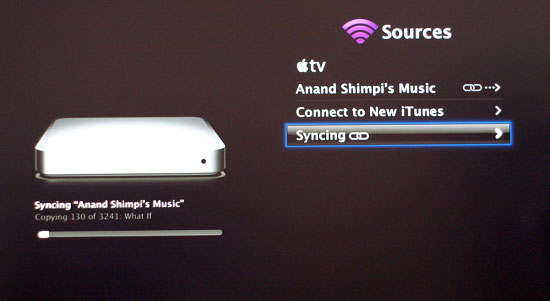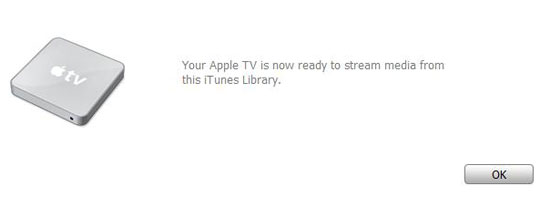Apple TV - Part 2: Apple Enters the Digital Home
by Anand Lal Shimpi on March 26, 2007 1:22 AM EST- Posted in
- Mac
I Don't Stream, I Sync
There's a big difference between how most media extenders get your content onto a TV and how the Apple TV goes about it. While the Apple TV can stream content from your computer, by default it is set to sync, not stream.

In sync mode, Movies, TV shows, music, podcasts and photos - the five main types of content that you can sync to the Apple TV - are all copied to the unit's internal 40GB hard drive. Synchronized content is prioritized in the order listed above, so if you fill up the Apple TV's hard drive, first photos are deleted, then podcasts, then music, then TV shows and finally movies to make room for any new content you are trying to sync to the device.

Apple recommends syncing vs. streaming for slower networks, especially if we're talking about low signal wireless. If you've got easily accessible Ethernet jacks or 802.11n, the benefits of syncing are no longer as clear. Armed with Apple's new Airport Extreme 802.11n base station, we measured the amount of time to transfer a 700MB movie to the Apple TV at 3 minutes and 46 seconds (approximately 3.1MB/s). The base station was in a separate room from the Apple TV (approximately 30 feet away), although signal strength was good at 4 bars during the transfer.
Then there's the issue of space; if the amount of content you have greatly exceeds the fixed capacity of the Apple TV then you may be better off disabling sync altogether and just use the Apple TV as a streaming extender.
While you can only have a single computer synced to Apple TV, you can have up to five others setup to stream content to the unit. Streaming works just as you'd expect it to: the data remains stored on the host computer(s) and is sent over to Apple TV as it is requested - nothing is ever permanently stored on the hard drive. Streaming is obviously useful for situations where your iTunes collection is too vast for Apple TV's 40GB hard drive, but it also comes in handy when you have more than one system to stream content from.

To add additional computers to Apple TV, select sources from the main menu, then connect to new iTunes. A new 5 digit code will appear on the screen which, when supplied to iTunes running on the new computer, will send a list of content over to Apple TV. Repeat this process up to a total of five times to add additional iTunes content to Apple TV.

Apple TV does keep the content separate, so in order to browse streamed content from one computer you have to first select it as a source. Once selected, all other content, regardless of streamed or synced, is not available except for what's provided by that source. To switch to another computer or Apple TV's local storage, a single click into the sources menu is all it takes. We would prefer a way to aggregate all content on a single network, but from a simplicity of content management perspective Apple's current approach makes sense.

In terms of performance, there's very little difference between synced and streamed content. Even when playing a movie over the network vs. locally, Apple TV does a great job of dealing with skipping ahead, so you can't tell the difference between streamed and synced content. Apple managed to make the debate of whether to stream or sync one of preference, not one of performance.










48 Comments
View All Comments
Awax - Monday, March 26, 2007 - link
AppleTV is almost standalone : you only need iTunes (free) on you Mac or PC. You can play files from the inner HD or stream from computers.XBOX 360 : same price as AppleTV, but you need a full Windows MCE, much more expensive (and not Mac compatible). You can only stream content from the WinMCE computer which needs to be swicthed on. And AppleTV frontRow is said to be simpler.
yyrkoon - Monday, March 26, 2007 - link
I dont know about any one else, but if I'm buying an XBOX-360, the last thing in the world I would be concerned about, is if it is 'apple compliant'. Matter of a fact, the last thing in the world I want, is ANYTHING 'apple compliant'. But hey. thats me, just call me a MAC biggot, if you must . . .
Awax - Monday, March 26, 2007 - link
As staded on 1st page, the iPod success came from the MP3 capacity of being at the same time 100% legitimate and 100% pirated. It is the main format for pirated music but you can legally rip all your CDs to MP3.For AppleTV, the trouble is that there are no legitimate way of getting unDRMed version of videos. 99% of digital version of movies are stuck in DRM (DVD, HD/DVD/BlueRay, VoD, ...) and converting them to another format hits the DMCA (or equivalent local legislation).
Currently, 99% of ripped video content are distributed as AVI or MKV files, encoded mainly in DivX/XviD. More recent pirated movies are released in H264.
The solution for the AppleTV can only come from the pirates themselves. As MP4/H264 can be read on nearly every PC (Mac or Win), pirates just have to switch from MKV container to MP4 (almost same features) and keep their H264/AAC encoding process. For this last part, they just have to check that their content is compatible with AppleTV H264 limitation : currently, pirates are using the full H264 specification, even the latest options, which are not supported by QuickTime nor iTunes. And QuickTime/iTunes/AppleTV can only support stereo AAC, not 2.1 or 5.1 AAC.
If pirates are targeting a specific device (with rather broad and open standards), this can break AppleTV's major limitation.
yyrkoon - Tuesday, March 27, 2007 - link
Here is something, for at least 'food for thought"http://www.tgdaily.com/index.php?option=com_conten...">AnyDVD now rips HD DVD/Blueray
JarredWalton - Monday, March 26, 2007 - link
The other major problem is that a high quality encode of a DivX file can be accomplished in about 2-3 hours on a reasonably fast Core 2 Duo setup (say, E6600). If you drop quality a bit, you can get it done in half that time - and I'm talking about typically full length movies for that time frame.H.264 encoding easily takes twice as long in my experience and it's not nearly as flexible if you need to target the specific Apple TV standards (i.e. only 5 Mbps and 720p - I can see 720p being fine, but quality at 5Mbps is debatable for some). Then you have a lot of devices that support DivX/Xvid... but not Apple TV's H.264. Decoding of H.264 is also a LOT more complex than DivX HD - a 1280x720 DivX file easily runs on a midrange Pentium M or similar CPU; H.264 requires dual cores or GPU acceleration.
I personally don't see this device as catering to the necessary market to get lots of illegal content. I think that decision has already come and gone, so without something substantially better (and Apple TV's content requirements are not going to qualify), people will stick with what they already have.
Awax - Monday, March 26, 2007 - link
For transcoding, you can use other tools than Quicktime : x264 is a better/faster encoder for H264 and it supports more than 2 CPUs. So on a Quad MacPro, you'll use all power available. You just need to have the proper H264 profile/level for the AppleTV.Encoding/transcoding is not really a problem because it needs to be done only once : you might see new "AppleTV compliant" pirate release appear on your favorite "multimedia content provider".
Finally, AppleTV is not the only device playing H264 encoded content. The iPod does. And my Archos 604 does. Actually, I'm trying to find the ultimate encoding format to ripp my DVDs (I know, this is bad) so I can play them on my Archos and on the AppleTV I might buy if I can find such a format.
Spoelie - Monday, March 26, 2007 - link
you want to have movies that display on your typical 50" HDTV in the same format as the ones displaying on your 1" IpOD?Good luck finding a good compromise.
Awax - Monday, March 26, 2007 - link
I don't have a video iPod, I have an http://www.archos.com/products/video/archos_604wif...">Archos 604 (4.3" wide screen, plays video up to DVD resolution in MPEG4 ASP (DivX), MPEG4 AVC (H264), MPEG2 and WMV with AAC and AC3).So, if I encode my DVD in their native resolution, I'll be able to play them on both my 604 and my 42" HDReady TV.
artifex - Monday, March 26, 2007 - link
1) I've heard that skipping around in a movie can cause a problem, especially while streaming. Did you find it was always smooth?2)I've heard that if you create a slideshow with synced sound, the slideshow will work, but the AppleTV will ignore the music you synced and pick some other music. Did you try this feature and can you confirm whether this is the case?
giantpandaman2 - Monday, March 26, 2007 - link
Poor resolution is a huge problem. Also, given your discussion of video bitrates and their effect on video resolution you make no comment about audio decoding, or even if there is any besides stereo. I assume it can pass through digitally encoded audio through the HDMI or Optical, but how high does iTunes actually go?What about the price factor? $299 is a decent price for computer hardware, but compare that to $299/399 for an Xbox360 and I have to ask, what's the better deal? I'm not trying to toot the 360's horn--I don't even own one--but I'm genuinely curious as to which makes a better media extender. Off hand I'd guess the 360 due to resolution (especially once the HDMI version hits), horsepower, and the ability to buy content directly from the box, but that's only a guess. Where's your commentary on that?
Looking at the price and specs of the Apple TV I really expected a harsher verdict. To me the Apple TV looks quite weak, fine for hardcore Apple die hards, but for everyone else wait a few more iterations/generations. I also gotta ask-is a hacked old Xbox a better extender than the Apple TV? Maybe not for mainstream--but Anandtech readers are hardly that.